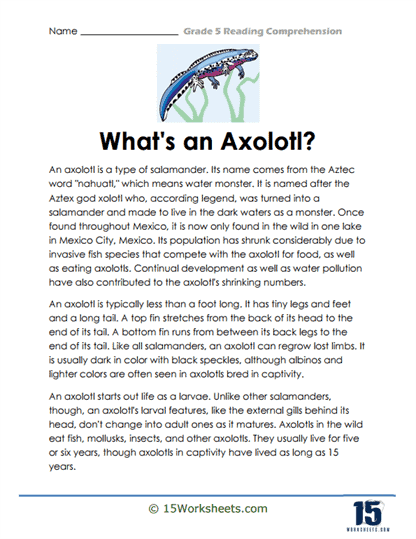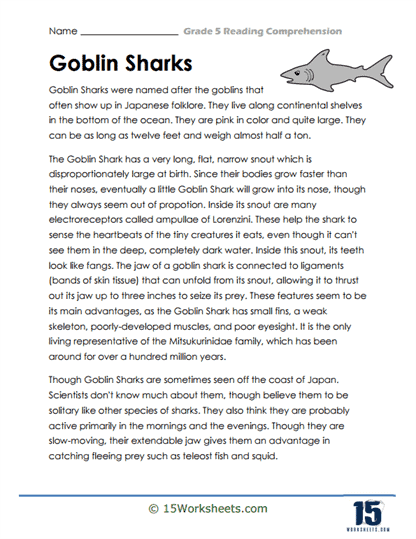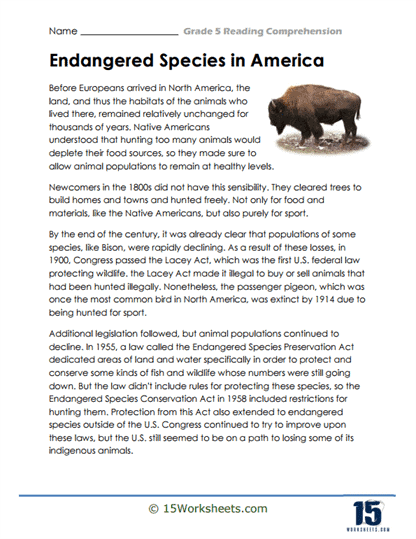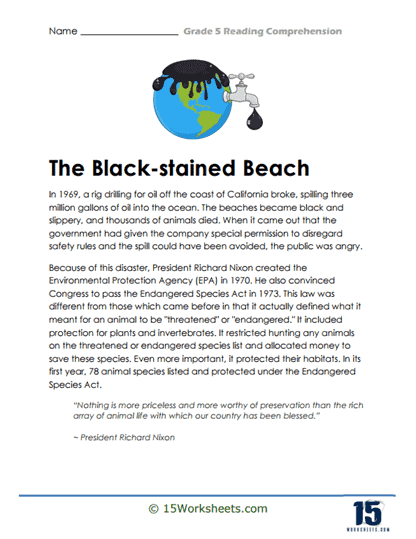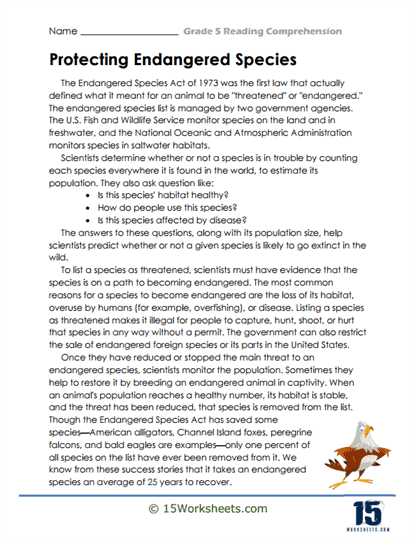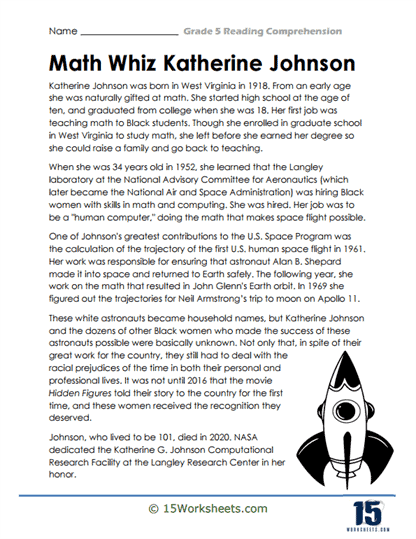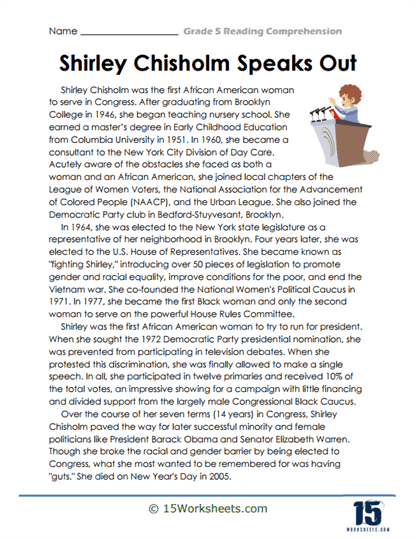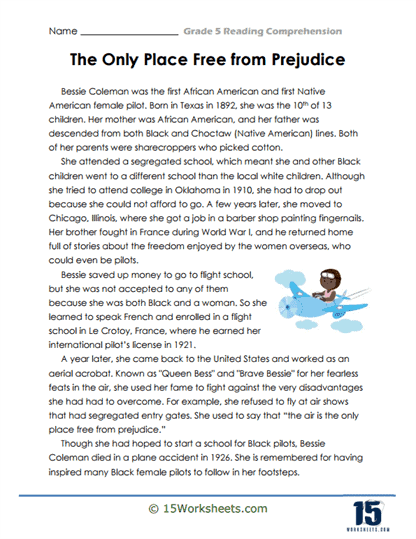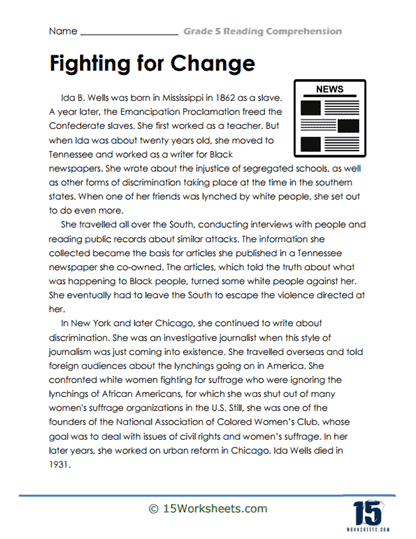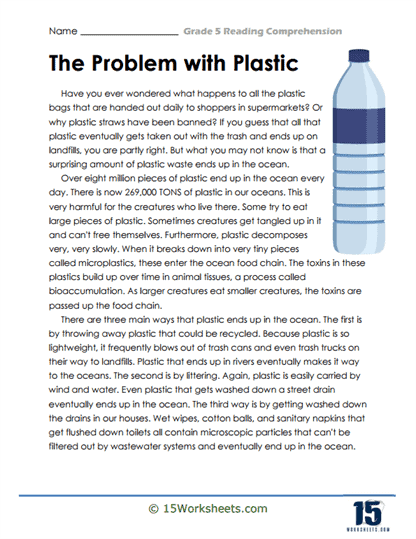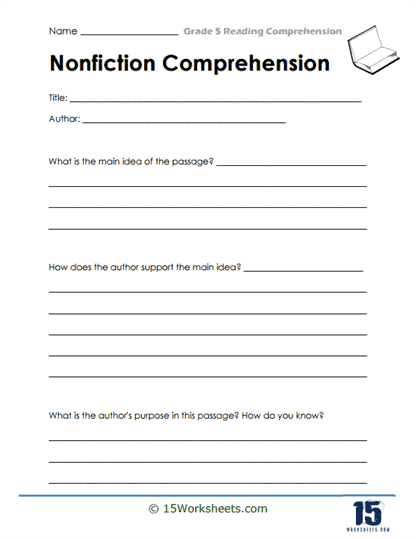Grade 5 Reading Comprehension Worksheets
All About These 15 Worksheets
These worksheets were designed for 5th grade students and offer an engaging way to sharpen reading skills, enhance comprehension, and build critical thinking abilities. These worksheets are more than just tools for reading practice; they are carefully structured learning experiences aimed at developing a range of essential academic skills. By providing a variety of reading passages, these worksheets challenge young learners to not only read but to deeply understand and engage with the material.
At the heart of these worksheets lies the goal of improving reading comprehension. Each worksheet presents a passage, which may come in the form of a short story, an article, or an informational text. After reading, students are prompted with a series of questions that push them to demonstrate their understanding. These questions may ask students to pinpoint the main idea, identify important details, explain the meaning of certain words based on the context, or even express their opinion about the text. Through this process, students practice extracting key information, interpreting the writer’s intent, and reflecting on their own understanding. As they work through these tasks, they learn to become more thoughtful, independent readers.
The passages provided in these worksheets are diverse in both topic and style, exposing students to a range of genres, including fiction, nonfiction, and expository writing. This variety serves an important purpose: it helps students adapt to different types of texts, each with its unique structure, tone, and purpose. Whether the passage is a scientific article about endangered species or a historical account of a famous leader, students are encouraged to think critically about what they are reading. They are not merely passive recipients of information but are asked to engage actively with the material, to consider what it means, and to reflect on how it connects to their own knowledge or experiences.
One of the most powerful aspects of these worksheets is their ability to cultivate critical thinking skills. The questions go beyond simple recall and encourage students to analyze and evaluate the material. For example, a passage about environmental conservation might ask students to think about the causes and consequences of deforestation or pollution. Students are invited to connect these ideas to broader concepts such as human impact on the environment, global warming, or sustainability. Similarly, texts about historical events or figures often prompt students to consider the moral or ethical lessons that can be drawn from the past. This kind of questioning not only enhances their comprehension but also deepens their capacity to think critically about the world around them.
In addition to comprehension and critical thinking, vocabulary development plays a significant role in these worksheets. The passages are often rich with new and advanced vocabulary that is appropriate for the fifth-grade level. Students are tasked with deciphering the meanings of these unfamiliar words through context clues, which strengthens their ability to understand more complex texts in the future. Expanding vocabulary in this way is a crucial step in academic growth, as it equips students with the language skills they need to express themselves more effectively and engage with increasingly sophisticated material as they advance in their studies.
The interdisciplinary nature of the reading passages offers another valuable layer to these worksheets. Students encounter topics that span across various subject areas such as science, history, culture, and social issues. This not only makes the reading more interesting and varied but also helps students make connections between different areas of knowledge. For instance, reading about space exploration may spark curiosity in science, while a passage on historical injustices may prompt discussions about ethics, empathy, and social responsibility. The more students read about diverse topics, the broader their understanding of the world becomes. This knowledge is not isolated to reading alone; it enriches their overall education and fosters a well-rounded perspective on different global issues.
Many of the topics addressed in these worksheets encourage the development of empathy and social awareness. Texts that focus on historical injustices, human rights, or environmental challenges provide opportunities for students to reflect on the world’s complexities and the responsibilities we share as global citizens. For instance, a reading passage about a famous civil rights leader might inspire students to think about the importance of equality and justice, while a text on environmental conservation might encourage them to consider how they can contribute to protecting the planet. By relating their reading to real-world issues, students not only improve their academic skills but also develop a stronger sense of empathy and social consciousness.
In addition to these academic benefits, the worksheets also promote the development of practical reading strategies that can be applied to all forms of reading. Students learn how to approach a text with focus and intention. Techniques such as underlining key information, taking notes in the margins, and using context clues to understand difficult words are all strategies reinforced through these exercises. These skills are essential for reading fluency, as they teach students how to navigate complex texts more efficiently. Over time, these strategies become second nature, allowing students to approach any reading task with greater confidence and ease.
As students engage with these worksheets regularly, they will likely notice improvements in both their reading speed and fluency. The more they practice, the more comfortable they become with processing and understanding information quickly and accurately. This not only makes reading more enjoyable but also prepares them for more advanced academic challenges in the future. When reading becomes less of a chore and more of a natural skill, students are more likely to develop a love for literature and learning that will benefit them throughout their education.
What Reading Skills Are Students Learning in Grade 5?
In Grade 5, students continue to build upon and refine their reading skills. Some of the key reading skills that are typically focused on in Grade 5 include:
Reading Comprehension and Fluency
Comprehension is the ability to understand and make meaning from what is read. In Grade 5, students develop more advanced comprehension skills, including identifying main ideas, supporting details, cause and effect relationships, making inferences, drawing conclusions, and summarizing texts.
Fluency refers to the ability to read accurately, smoothly, and with expression. In Grade 5, students work on improving their reading speed while maintaining comprehension. They practice reading aloud, use punctuation cues, and work on phrasing to enhance their fluency.
Students also work on expanding their vocabulary by encountering new words in various texts. They learn strategies to determine the meaning of unfamiliar words using context clues, word roots, prefixes, and suffixes. Grade 5 students continue to develop and apply reading strategies to enhance comprehension. These strategies may include making predictions, visualizing, making connections to prior knowledge, asking questions, summarizing, and monitoring their understanding as they read.
Text Structure
Students learn to recognize and understand different text structures, such as narrative (story), expository (informational), persuasive, and descriptive texts. They become familiar with how authors organize information, including the use of headings, subheadings, paragraphs, and transitional words. Students explore various literary elements, such as character development, plot, setting, theme, and point of view. They analyze texts to understand the author’s purpose and the deeper meanings within the story.
Students learn to critically analyze and evaluate texts by considering the author’s perspective, bias, and purpose. They distinguish between fact and opinion, evaluate the credibility of sources, and develop their own opinions based on evidence from the text. Encouraging independent reading is important in Grade 5. Students are encouraged to read a variety of texts, including fiction, nonfiction, poetry, and articles, to further develop their reading skills, expand their interests, and foster a love for reading.
How to Help 5th Graders Become Better Readers
Improving reading comprehension involves several strategies and methods. Here’s a detailed guide for a 5th grader looking to enhance their reading comprehension skills:
Active Reading – Active reading means fully engaging with the text. Don’t just let your eyes pass over the words; think about what you’re reading. Ask yourself questions (who, what, where, when, why, how) about the text as you read, and make predictions about what might happen next. This can make the reading process more engaging and help you better understand the material.
Take Notes – Jot down main ideas, key details, unfamiliar words, and any questions that come up while you’re reading. If you’re reading a book, you can use sticky notes. If you can’t write in the book you’re reading, keep a separate notebook for your notes.
Visualize and Summarize – Imagine the events, characters, setting, and plot in your mind as if they were a movie. Visualization can make the reading experience more enjoyable and help you remember details more easily. After each section or chapter, try to summarize what you’ve read in your own words. This can help you consolidate your understanding and recall key points. You can write these summaries in your notebook.
Look Up New Vocabulary – If you come across words you don’t know, try to figure out their meaning from the context. If you can’t, look them up in a dictionary. Understanding the vocabulary in a text is crucial for comprehension. Try to relate the text to your own experiences, knowledge, or other books you’ve read. Making these connections can help you understand the text on a deeper level.
Reread Difficult Passages – If something doesn’t make sense the first time you read it, don’t hesitate to reread it. Sometimes, understanding comes with repeated reading. Reading aloud can slow down your reading and force you to pay attention to the words and their meaning. It can also improve your pronunciation and fluency.
Discuss What You Read – Talk about what you’re reading with others – your friends, family, or teachers. Discussing the text can help you understand it better and remember it more effectively. You can share your interpretations, ask questions, and hear other perspectives.
Use Graphic Organizers – Graphic organizers like Venn diagrams, story maps, or flow charts can help you organize information and ideas in the text, making it easier to understand and remember.
Remember, improving reading comprehension takes time and practice. Don’t be discouraged if you find it challenging at first. Keep reading regularly, and try to read a variety of genres and styles of writing to build your skills. It’s like exercising – the more you do it, the stronger your reading muscles will get!

